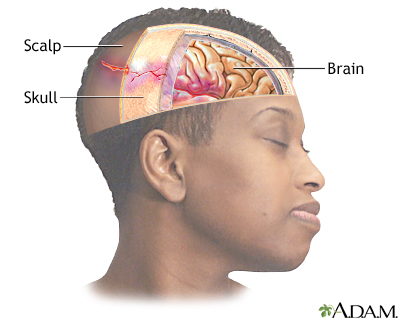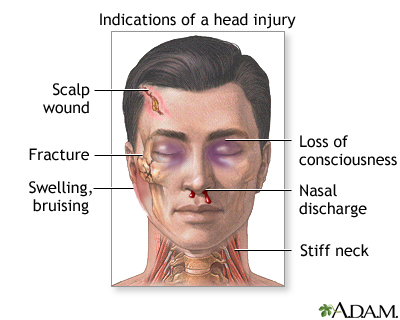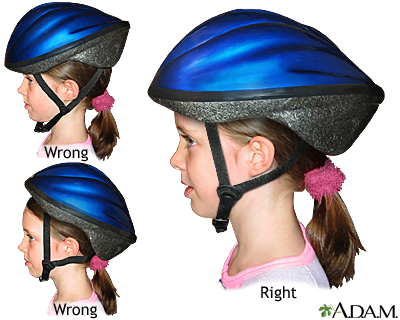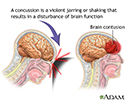Head injury - first aid
Brain injury; Head trauma
A head injury is any trauma to the scalp, skull, or brain. The injury may be only a minor bump on the skull or a serious brain injury.
Head injury can be either closed or open (penetrating).
- A closed head injury means you received a hard blow to the head from striking an object, but the object did not break the skull.
- An open, or penetrating, head injury means you were hit with an object that broke the skull and entered the brain. This is more likely to happen when you move at high speed, such as going through the windshield during a car accident. It can also happen from a gunshot to the head.
Head injuries include:
-
Concussion
, in which the brain is shaken, is the most common type of traumatic brain injury.
Concussion
A concussion may occur when the head hits an object, or a moving object strikes the head. A concussion is a minor or less severe type of brain injur...
 ImageRead Article Now Book Mark Article
ImageRead Article Now Book Mark Article - Scalp wounds.
- Skull fractures.
Head injuries may cause bleeding:
- In the brain tissue
-
In the layers that surround the brain (
subarachnoid hemorrhage
,
subdural hematoma
,
extradural hematoma
)
Subarachnoid hemorrhage
Subarachnoid hemorrhage is bleeding in the area between the brain and the thin tissues that cover the brain. This area is called the subarachnoid sp...
Read Article Now Book Mark ArticleSubdural hematoma
A subdural hematoma is a collection of blood between the covering of the brain (dura) and the surface of the brain.
 ImageRead Article Now Book Mark Article
ImageRead Article Now Book Mark ArticleExtradural hematoma
An epidural hematoma (EDH) is bleeding between the inside of the skull and the outer covering of the brain (called the dura).
Read Article Now Book Mark Article
Head injury is a common reason for an emergency room visit. A large number of people who suffer head injuries are children. Traumatic brain injury (TBI) accounts for over 1 in 6 injury-related hospital admissions each year.
Causes
Common causes of head injury include:
- Accidents at home, work, outdoors, or while playing sports
- Falls
- Physical assault
- Traffic accidents
Most of these injuries are minor because the skull protects the brain. Some injuries are severe enough to require a stay in the hospital.
Symptoms
Head injuries may cause bleeding in the brain tissue and the layers that surround the brain (subarachnoid hemorrhage, subdural hematoma, epidural hematoma).
Symptoms of a head injury can occur right away. Or symptoms can develop slowly over several hours or days. Even if the skull is not fractured, the brain can hit the inside of the skull and be bruised. The head may look fine, but problems could result from bleeding or swelling inside the skull.
The spinal cord is also likely to be injured in any serious trauma.
Some head injuries cause changes in brain function. This is called a traumatic brain injury. Concussion is a mild traumatic brain injury. Symptoms of a concussion can range from mild to severe.
Symptoms of a concussion
A concussion may occur when the head hits an object, or a moving object strikes the head. A concussion is a minor or less severe type of brain injur...

First Aid
Learning to recognize a serious head injury and give basic first aid can save someone's life. For a moderate to severe head injury, CALL 911 RIGHT AWAY.
Get medical help right away if the person:
- Becomes very sleepy
- Behaves abnormally
- Develops a severe headache or stiff neck
- Has pupils (the dark central part of the eye) of unequal sizes
- Is unable to move an arm or leg
- Loses consciousness, even briefly
- Vomits more than once
Then take the following steps:
-
Check the person's airway, breathing, and circulation. If necessary, begin rescue breathing and
CPR
.
CPR
CPR stands for cardiopulmonary resuscitation. It is an emergency lifesaving procedure that is done when someone's breathing or heartbeat has stopped...
Read Article Now Book Mark Article -
If the person's breathing and
heart rate
are normal but the person is unconscious, treat as if there is a
spinal injury
. Stabilize the head and neck by placing your hands on both sides of the person's head. Keep the head in line with the spine and prevent movement. Wait for medical help.
Heart rate
The pulse is the number of heartbeats per minute.
 ImageRead Article Now Book Mark Article
ImageRead Article Now Book Mark ArticleSpinal injury
The spinal cord contains the nerves that carry messages between your brain and body. The cord passes through your neck and back. A spinal cord inju...
 ImageRead Article Now Book Mark Article
ImageRead Article Now Book Mark Article - Stop any bleeding by firmly pressing a clean cloth on the wound. If the injury is serious, be careful not to move the person's head. If blood soaks through the cloth, do not remove it. Place another cloth over the first one.
- If you suspect a skull fracture, do not apply direct pressure to the bleeding site, and do not remove any debris from the wound. Cover the wound with sterile gauze dressing.
- If the person is vomiting, to prevent choking, roll the person's head, neck, and body as one unit onto their side. This still protects the spine, which you must always assume is injured in the case of a head injury. Children often vomit once after a head injury. This may not be a problem, but call a doctor for further guidance.
- Apply ice packs to swollen areas.
Do Not
Follow these precautions:
- Do NOT wash a head wound that is deep or bleeding a lot.
- Do NOT remove any object sticking out of a wound.
- Do NOT move the person unless absolutely necessary.
- Do NOT shake the person if he or she seems dazed.
- Do NOT remove a helmet if you suspect a serious head injury.
- Do NOT pick up a fallen child with any sign of head injury.
- Do NOT drink alcohol within 48 hours of a serious head injury.
A serious head injury that involves bleeding or brain damage must be treated in a hospital.
For a mild head injury, no treatment may be needed. However, watch for symptoms of a head injury, which can show up later.
Your health care provider will explain what to expect, how to manage any headaches, how to treat your other symptoms, when to return to sports, school, work, and other activities, and signs or symptoms to worry about.
-
Children will need to be watched and make activity changes
.
Children will need to be watched and ma...
Mild brain injury in children - discharge; Brain injury in children - discharge; Mild traumatic brain injury in children - discharge; Closed head inj...
Read Article Now Book Mark Article -
Adults also need close observation and activity changes
.
Adults also need close observation and ...
Brain injury - concussion - discharge; Traumatic brain injury - concussion - discharge; Closed head injury - concussion - discharge
Read Article Now Book Mark Article
Both adults and children must follow the provider's instructions about when it will be possible to return to sports.
When to Contact a Medical Professional
Call 911 right away if:
- There is severe head or face bleeding.
- The person is confused, tired, or unconscious.
- The person stops breathing.
-
You suspect a serious head or
neck injury
, or the person develops any signs or symptoms of a serious head injury.
Neck injury
The spinal cord contains the nerves that carry messages between your brain and body. The cord passes through your neck and back. A spinal cord inju...
 ImageRead Article Now Book Mark Article
ImageRead Article Now Book Mark Article
Prevention
Not all head injuries can be prevented. The following simple steps can help keep you and your child safe:
Simple steps
Concussion - preventing in children; Traumatic brain injury - preventing in children; TBI - children; Safety - preventing head injury
- Always use safety equipment during activities that could cause a head injury. These include seat belts, bicycle or motorcycle helmets, and hard hats.
-
Learn and follow
bicycle safety recommendations
.
Bicycle safety recommendations
Many cities and states have bike lanes and laws that protect bicycle riders. But riders are still at risk of being hit by cars. Therefore, you need...
 ImageRead Article Now Book Mark Article
ImageRead Article Now Book Mark Article - Do not drink and drive, and do not allow yourself to be driven by someone who you know or suspect has been drinking alcohol or is impaired in another way.
References
Heegaard WG, Biros MH, Head injury. In: Marx JA, Hockberger RS, Walls RM, et al, eds. Rosen's Emergency Medicine: Concepts and Clinical Practice . 8th ed. Philadelphia, PA: Elsevier Saunders; 2014:chap 41.
Liebig CW, Congeni JA. Sports-related traumatic brain injury (concussion). In: Kliegman RM, Stanton BF, St Geme JW, Schor NF, eds. Nelson Textbook of Pediatrics. 20th ed. Philadelphia, PA: Elsevier; 2016:chap 688.
-
Head injury
Animation
-
Concussion - illustration
A concussion may result when the head strikes against an object or is struck by an object. Concussions may produce unconsciousness or bleeding in or around the brain.
Concussion
illustration
-
Bicycle helmet - proper usage - illustration
Helmets can save lives and prevent trauma, but only if they are worn properly. A helmet should be worn squarely on the top of the head, covering the top of the forehead. The chinstrap must be fastened and the helmet should fit snugly and comfortably. The helmet should not be able to move side-to-side or front-to-back. Most helmets come with removable pads so you can customize the fit for any child.
Bicycle helmet - proper usage
illustration
-
Head injury - illustration
Head injuries can range from a minor bump on the head to a devastating brain injury. Learning to recognize a serious head injury, and implementing basic first aid, can make the difference in saving someone's life. Common causes of head injury include traffic accidents, falls, physical assault, and accidents at home, work, outdoors, or while playing sports.
Head injury
illustration
-
Intracerebellar hemorrhage - CT scan - illustration
Intracerebellar hemorrhage shown by CT scan. This hemorrhage followed use of t-PA.
Intracerebellar hemorrhage - CT scan
illustration
-
Indications of head injury - illustration
Head injury can be classified as either closed or penetrating. In closed head injury, the head sustains a blunt force by striking against an object. In penetrating head injuries, a high velocity object breaks through the skull and enters the brain. The signs and symptoms of a head injury may occur immediately or develop slowly over several hours.
Indications of head injury
illustration
-
Concussion - illustration
A concussion may result when the head strikes against an object or is struck by an object. Concussions may produce unconsciousness or bleeding in or around the brain.
Concussion
illustration
-
Bicycle helmet - proper usage - illustration
Helmets can save lives and prevent trauma, but only if they are worn properly. A helmet should be worn squarely on the top of the head, covering the top of the forehead. The chinstrap must be fastened and the helmet should fit snugly and comfortably. The helmet should not be able to move side-to-side or front-to-back. Most helmets come with removable pads so you can customize the fit for any child.
Bicycle helmet - proper usage
illustration
-
Head injury - illustration
Head injuries can range from a minor bump on the head to a devastating brain injury. Learning to recognize a serious head injury, and implementing basic first aid, can make the difference in saving someone's life. Common causes of head injury include traffic accidents, falls, physical assault, and accidents at home, work, outdoors, or while playing sports.
Head injury
illustration
-
Intracerebellar hemorrhage - CT scan - illustration
Intracerebellar hemorrhage shown by CT scan. This hemorrhage followed use of t-PA.
Intracerebellar hemorrhage - CT scan
illustration
-
Indications of head injury - illustration
Head injury can be classified as either closed or penetrating. In closed head injury, the head sustains a blunt force by striking against an object. In penetrating head injuries, a high velocity object breaks through the skull and enters the brain. The signs and symptoms of a head injury may occur immediately or develop slowly over several hours.
Indications of head injury
illustration
-
Epilepsy
(In-Depth)
-
Sinusitis
(In-Depth)
-
Alzheimer disease
(In-Depth)
-
Colds and the flu
(In-Depth)
Review Date: 11/4/2015
Reviewed By: Jesse Borke, MD, FACEP, FAAEM, Attending Physician at FDR Medical Services/Millard Fillmore Suburban Hospital, Buffalo, NY. Also reviewed by David Zieve, MD, MHA, Isla Ogilvie, PhD, and the A.D.A.M. Editorial team.









